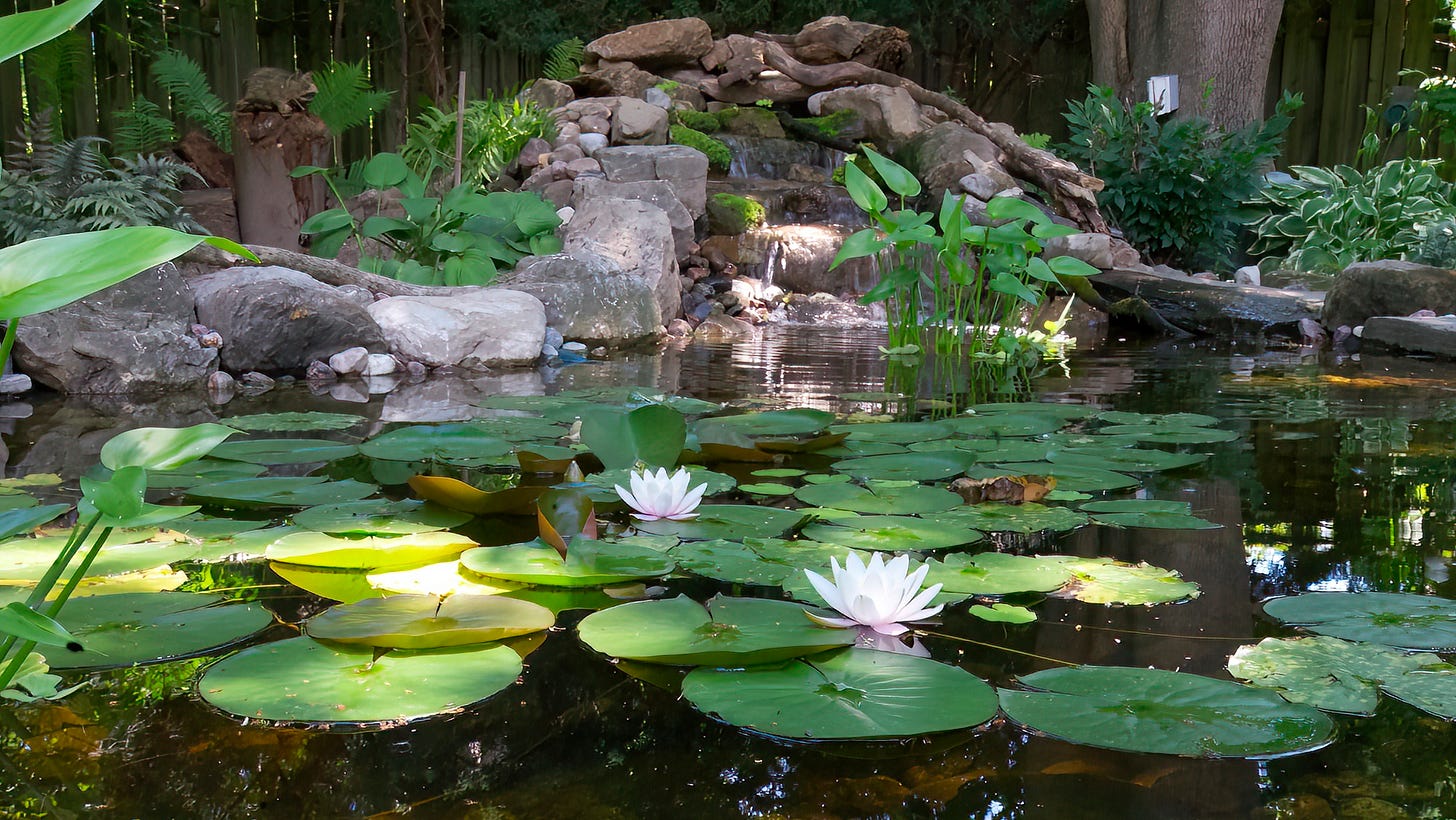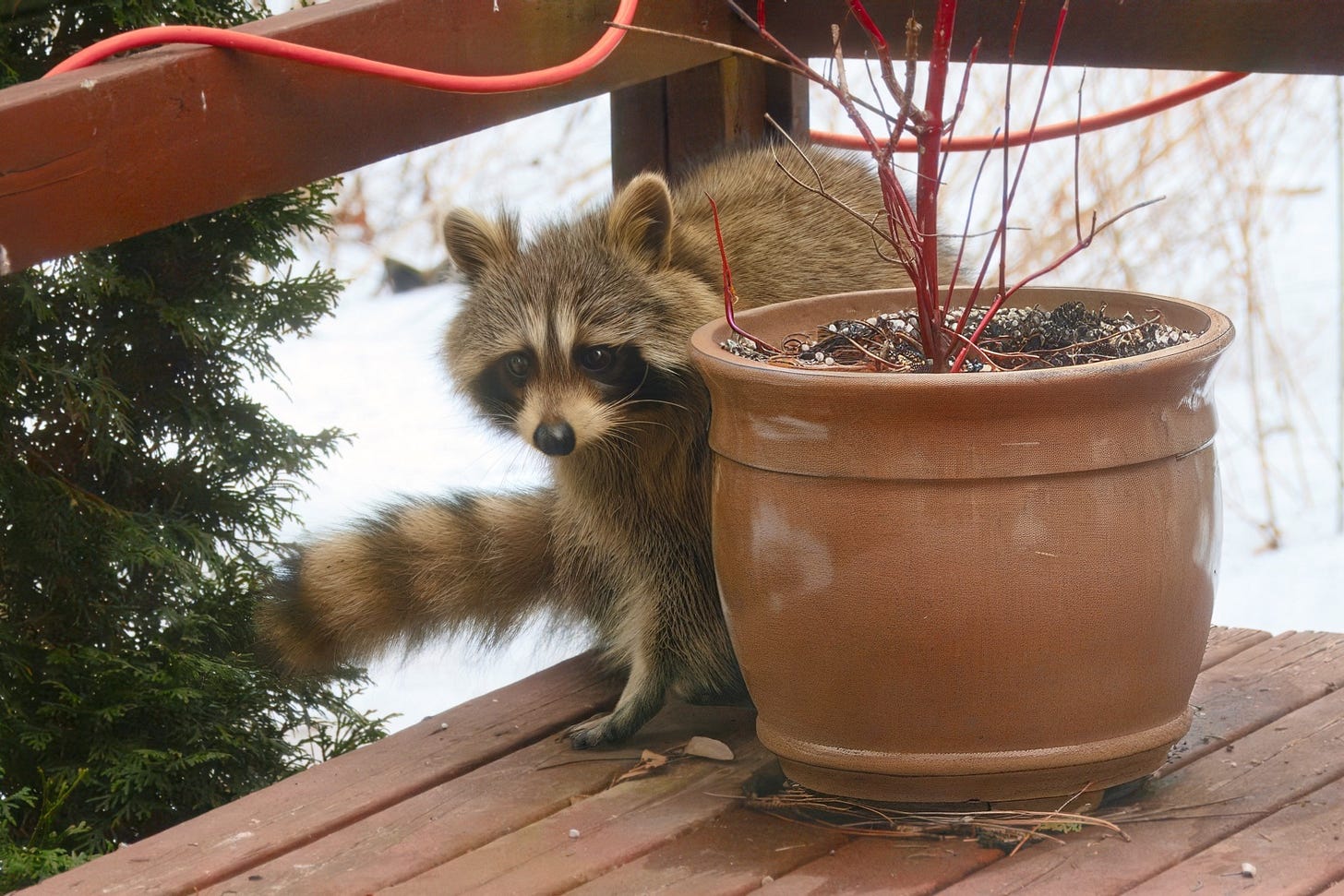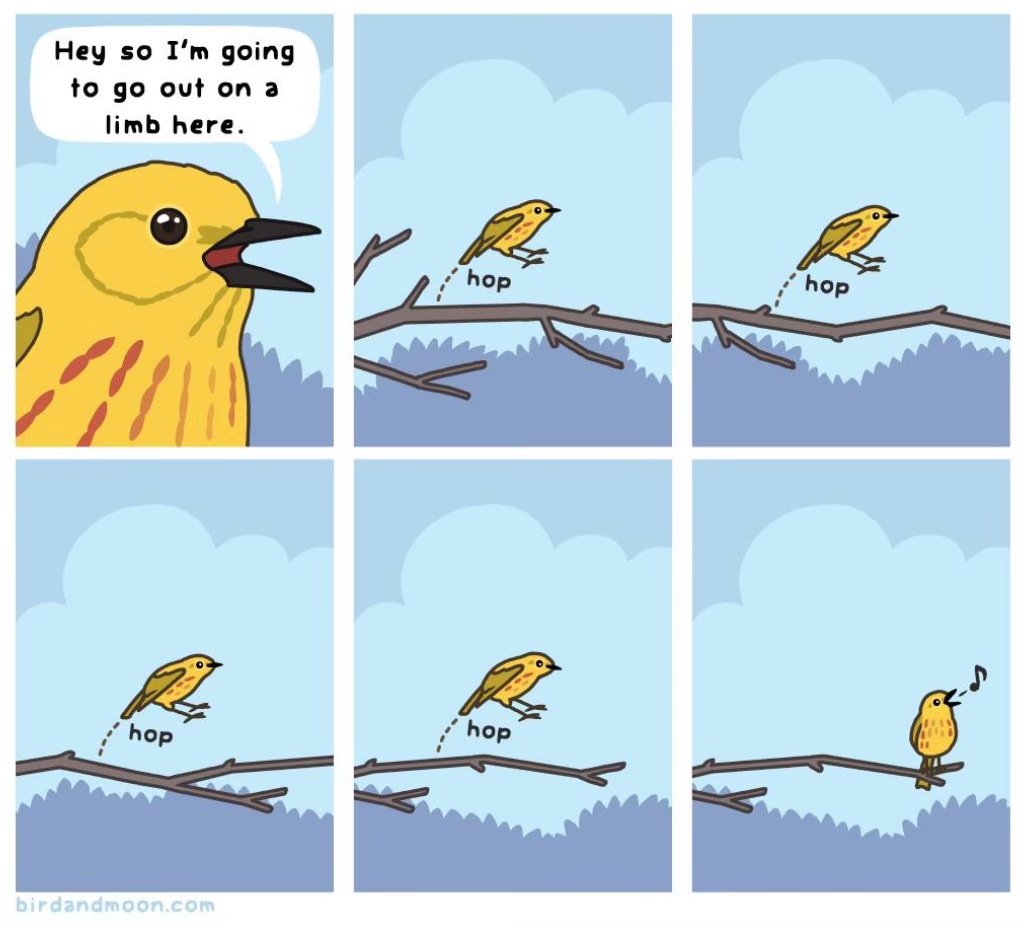Time to plan for a Wildlife Summer
Moving on from last week’s topic of Spiders. I had been a little wary about that but it proved to be surprisingly popular. The snow here has been melting this week and although there are still patches of dirty white here and there, the ground is starting to dry out. Warming up of the soil will take a little longer. Frankly, after three months under snow the place looks a mess, as it always does. When I was interviewing in England 27 years ago for the job that brought me to Montreal (great decision) the CEO of the company recruiting me waxed lyrical about the hot summers and winter skiing and the wonderful fall colours in the forests - all true. He then spoiled it by describing March as the “mucky month” and it has reliably lived down to his decryption every year we have been here. If ever I were to travel to avoid Montreal weather, March is the month I would choose to absent myself.
But late March is also the time to plan our gardens. I know a good proportion of the readers here try to make their gardens welcoming to wildlife. Maybe simply a corner for butterflies, a pond for birds and frogs or going big with a total replacement of the lawn and a major makeover for wildlife as we have done. Every little helps to support suburban biodiversity.
Your garden must bring enjoyment to your life, as well as that of the animals that visit - don’t forget that. No need to be a purist. Plant flowers to attracted bees, butterflies, and maybe a family of raccoons, some rabbits, squirrels for sure will come to visit and perhaps settle in for the long term. Be ready for the day when you find a raccoon wearing a lost sun hat, trying to dig up your prized tomatoes. When that happens, instead of shooing it away, join the raccoon for a picnic. Share your garden, by turning it into a delightful, chaotic haven for all.
Note: I have illustrated this post with a few photographs taken in my own garden. Although I select my viewpoints carefully, please note that this is just a regular suburban plot, I do not live way out in the country or in the middle of a forest with acres to spare … much as I might like to. The only features we did not plant or arrange are the mature trees which were here when we arrived
Where to start? How to start? Some thoughts to set you going …
There are birds and insects around our gardens all year around - and you want them to stay, as they will with a little persuasion. There are many beautiful and interesting native plants that will support pollinator insects and are more enjoyable than those flashy, horticulturally modified, exotic imports … anyway, that’s my thinking.
Anyone can attract birds and other wildlife to their garden, however small, given a little work and ingenuity. Making your garden attractive to birds almost always makes it attractive to other beautiful creatures - butterflies for example.
I will be brief - there is a lot of detailed information available elsewhere. The main point is to encourage readers to consider converting at least a portion of your gardens into wildlife corners. We have an amazing range of species of all sorts close to us, right outside our doors, if only we try to encourage them to join us.
A moderate wildlife garden needs some of these features. None of them will make your garden look scruffy, or “weedy”. Quite the opposite in fact.
Food and water. A dripping tap or a pond. A small waterfall is especially desirable.
Shelter from weather and predators, mostly provided by shrubs.
Nesting/breeding opportunities for resident birds.
Plants at three levels - a mixed environment. Ground cover, shrubs and trees.
Somewhere from which you can enjoy the plants and watch the wildlife
Desirable features include discrete piles of leaves and twigs, especially for the winter. Birds and other wildlife do not usually want “tidy” gardens. Pile up some logs left over from the firewood stack in a corner - the nooks and crannies shelter insects and in turn attract foraging birds. Loose and decaying wood and green matter hosts insects and fungi which in turn feed larger creatures.
Ideally grow some tree and shrub species that start the year covered in flowers plus others that end it groaning under a crop of berries. There are some birds that spend a majority of their lives no more than 10 feet from the ground, so a shrub layer is absolutely essential to their survival. Planting shrubs in groupings of three or more creates a thicket… excellent shelter, looks great too.
Keep some old and dying trees - you never know what quite unexpected birds and other creatures will arrive and so long as they are not in danger of falling on your head why would you remove them? Scruffy corners are highly desirable. This is hard for a Canadian gardener to get their heads around, but please DO NOT be too tidy in the autumn - a too clean garden with no litter is not good if you want to keep your wildlife from year to year.
Animals won't stay for long if they don't feel safe there, however attractive you have otherwise made it. Wide open spaces with few places to retreat to may look right to a traditional gardener and mirror the designs in the glossy magazines but they terrify most birds and small mammals who know that there are a lot of things out there just itching to eat them. The ideals include dense plantings, places with holes in, clear fly-ways, feeders distant from cat-hiding shrubs.
Nothing else that you place in your garden will have such an effect on the number of species you see as will a water feature ... be it a dripping tap, a puddle of water or a larger pond. Whatever is practical for you - just try hard to include water somehow.

Each spring during migration our own garden sees a dozen, or often more, species of warblers that drop in to see us. Often it seems they come solely to visit our pond and small waterfall. It never fails. If you do nothing else install some sort of water feature.
Your garden should ideally provide plenty of natural bird foods in addition to anything that you put out for them on feeders. Seeds, berries, nectar, fruit, nuts, buds, insects, worms, larvae, eggs, rodents, other birds. Remember - your plants don’t just have to attract birds directly, they should also attract creatures that birds like to eat.
It has been determined that a key threshold is 70%. If your yard has more than 70 percent native plants biomass, Chickadees, the studied species, have a better chance to reproduce and sustain their local population. Once the number of native plants drops much under 70%, that probability of sustaining the species falls.

To summarise, try to follow these ten simple points:
It doesn’t matter if you live on a farm or in an apartment, in the country or in a city – anyone can attract birds to their property given a little (pleasurable) work and some ingenuity.
1. Start by thinking like a bird or a rabbit!
A Wildlife Garden needs … Food and water, Shelter (from weather and predators), Nesting opportunities
2. Use three levels of vegetation to blend great design with great habitat
A mixed environment will please both birds and butterflies and bees and people.
Incorporating plants at three levels – a mixed environment – will provide all of the above requirements to make it attractive to birds At the same time, it will automatically incorporate the elements of good design needed to create an attractive garden.
3.Start with a base of low to the ground design elements
Ground cover plants – birds need somewhere to skulk when life seems threatening and a place to find tasty food such as insects and seeds.
Logs and rocks – Add rocks to provide a place to perch. Stack old firewood to simulate fallen trees. A pile of logs is important in a wildlife garden.
Lawns –Robins and Flickers rather like grass, so does the odd Sparrow, but most birds feel very exposed out there. Some grass is fine, but not too much and don’t cut it any shorter than necessary. Four inches is a height to aim for.
4. Add a mid-level layer of shrubs and bushes
Shrubs provide beauty as well as food and shelter for the birds.
Not just beautiful to look at, they also provide your feathered garden visitors a perch to look about from and shelter from inclement weather. Use plant species that start the year covered in flowers and end it with a crop of berries that provide food.
5. Look up – way up… add height with trees
Trees add beauty to please the gardener and offer built-in features that will make the birds happy too!
Even small young trees will make your garden more attractive to birds and over the years will mature into something of beauty. Plant some trees this season! Trees provide places to nest, to eat, sing and be seen. Different species build nests at different heights, so a nicely wooded lot will make your garden appealing to a variety of birds. If your garden is small then one medium sized tree is better than none.
6. Give yourself a break and don’t be too tidy!
Creatures love a messy garden and nothing says “welcome” like an old log. Really….scruffy corners are highly desirable! Leave piles of leaves and twigs, especially during the winter. In woodlands, fallen wood occurs naturally and many species have adapted to use this habitat. The nooks and crannies of old logs shelter insects and in turn attract foraging birds. Plenty of wildlife makes its home in dead wood, and use it as a source of food. You can usually find somewhere to put a pile of old logs or firewood, even in the smallest backyard. Place your old logs in a shady spot, so that it remains cool and damp. Leave a corner unraked in the fall to promote insect life and shelter for small rodents. Do not cut the heads of seed-bearing flowers before winter. Birds will feed on these seeds during the winter months.

7. Don’t forget the importance of shelter. Creatures need to feel safe!
Birds and rabbits and squirrels and raccoons won’t visit if they don’t feel safe! Add some sheltering elements though, and you’ll have them singing your praises from the tree-tops soon enough!
Shelter comes in many forms, be it a low level hedge, a pile of brush, an old tree stump or a majestic oak tree. If it can provide a place to perch or to hide, it will be a welcome haven for your feathered visitors.
8. Provide birds with a choice of feeder and food types
We all need choices – even the birds! Different species like different ways to have their food presented so offer a variety of feeder and seed types. Wrong seed types = no birds. Include tray or ground feeders, hopper feeders and tube feeders for large and small seeds
9. Provide a range of wild or natural foods
Variety is the spice of life … and another secret to a great wildlife garden!
Your plants don’t just have to attract birds and bees directly; they can also attract creatures birds like to eat. Insects, worms, larvae, eggs, rodents and other birds are all potential food sources that will attract birds to your garden. Add plants that provide seeds, berries, nectar, fruit, nuts and buds for abundant variety.
10. Just add water – the key ingredient in any birder’s garden
Nothing else that you place in your garden will have such an effect on the number of species you see as will a bit of water. From rain filling that little dip in your lawn to an elaborate pond, water is a bird magnet.
Moving water is a desirable feature to increase the range of species you are likely to see. No room for a pond? In a small garden or on an apartment balcony, simply a container of water such as an inverted dustbin lid or a shallow bucket will draw birds to it, especially if they can access the water by perching on the rim or on stones or twigs placed inside of it. Even just a dripping tap, or a slow trickle from the end of a hose can increase your bird “catch rate” tenfold.
Bird baths are readily available at a price point to please everyone. There is nothing quite so liable to bring you joy as watching a bird splash about in water. Easy to acquire and set-up, purchasing a bird bath adds instant beauty and bird-appeal to your yard. If you only choose to do one thing to attract more birds, a bird bath may be the easiest option. If it’s a heated one to offer open water in winter then so much the better.
Bonus #11 – Enjoy your garden!
Now all that’s left to do is to add somewhere to sit and watch and/or to photograph the birds from, pour yourself a drink and relax. After all that hard work you deserve it!
Final thought :
A well-managed wildlife garden enhances local ecology by improving air quality, increasing water retention and providing pollination avenues. These functions are critical in our fight against climate change. Encouraging natural predators, such as birds or ladybugs, can help keep unwanted pests in check.
These benefits are cyclical - the more wildlife thrives in your garden, the healthier and more balanced the ecosystem becomes, enhancing your garden’s vitality.
This link is to a short, and authoritative, article about bird feeding as we come out of winter. Recommended reading.












The hummingbird is feeding from Cuphea hybrid in a pot on the deck; they enjoy feeding from Lobelia cardinalis elsewhere in the garden. Mrs Gardener
Another excellent piece. I’d be interested in a future issue about how to attract pileated woodpeckers. My yard gets plenty of red bellied and downy woods but I only see pileated woodpeckers once every three or four years.